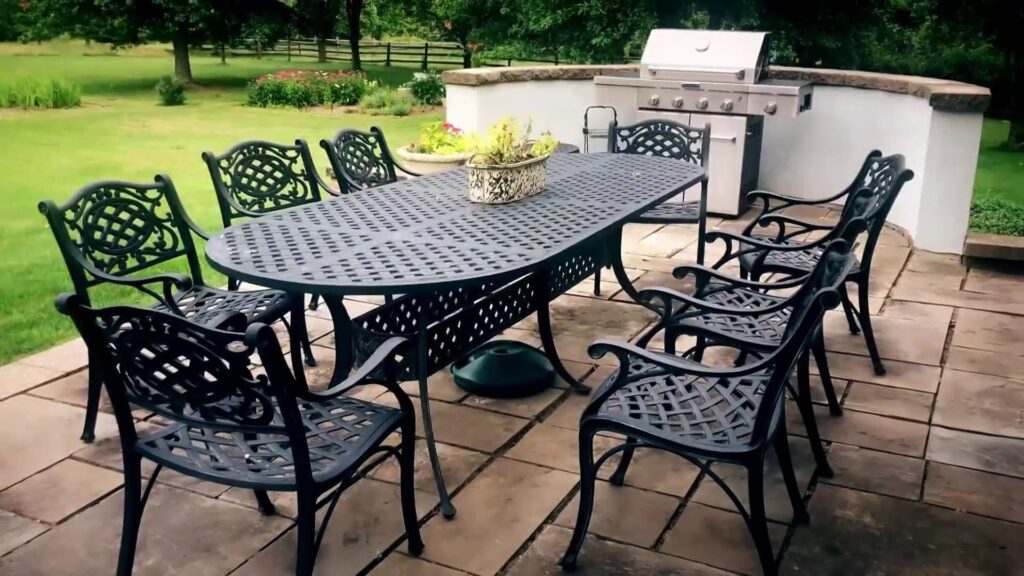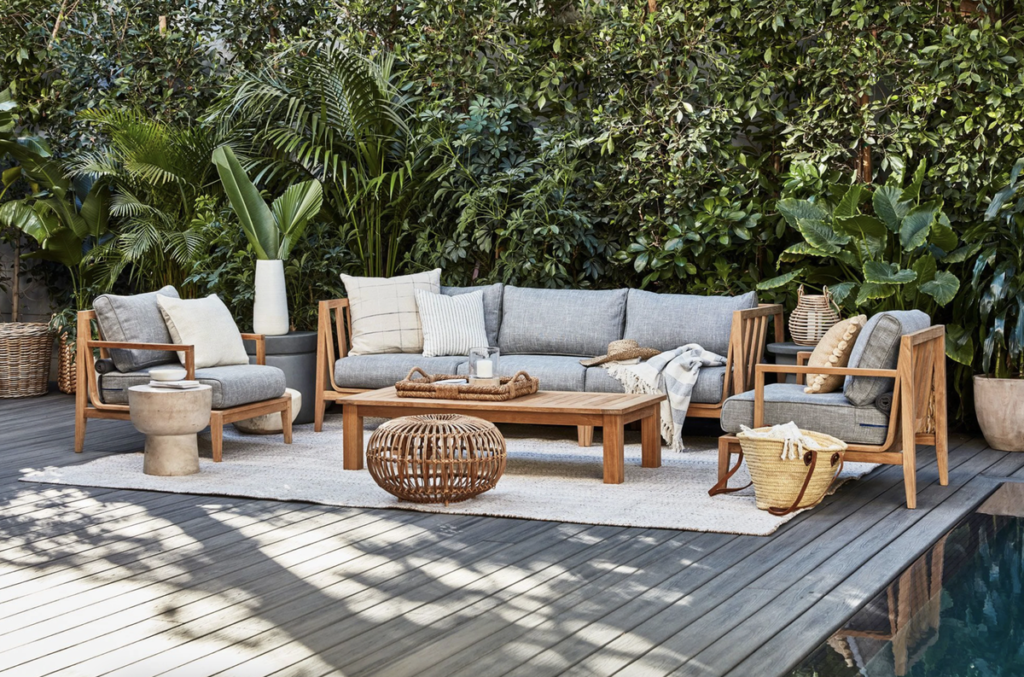Impact of Covid-19 Pandemic on the Furniture Industry
The Covid-19 pandemic has drastically impacted several industries around the world, and the furniture industry is no exception. As the pandemic spread across the globe, countries implemented lockdown measures to curb its spread. These measures led to a surge in demand for household items, especially those related to outdoor living spaces as people spent more time at home.
Due to this increased demand and disrupted supply chains, the furniture industry is facing shortages in patio furniture and outdoor products. While some furniture makers have experienced an uptick in demand, they are often unable to meet the needs of consumers due to supply chain disruptions. Shipping firms and raw material suppliers have also been affected, with shipping containers becoming scarce and raw material producers struggling with production due to supply chain issues.
One of the main reasons for the patio furniture shortage is due to the dependency on Chinese furniture suppliers. China is a major producer of outdoor furniture, and with the country being one of the earliest to be impacted by the pandemic, it led to significant delays in production and shipping. As a result, many retailers and suppliers had to diversify their supply chains, which added to the supply issues.
Moreover, the shortage of raw materials like polymer and aluminum has also contributed to the current situation. The chemical and polymer plants that create synthetic wicker and other materials used in outdoor furniture production temporarily closed due to the pandemic or were unable to fully operate due to supply chain disruptions. As a result, outdoor furniture manufacturers had to pay a higher price for raw materials, which led to an increase in the overall price of patio sets and outdoor furniture.
Industry experts predict that the outdoor furniture industry will continue to face supply issues in the coming months, but many are hopeful that the situation will improve as the risk of inflation fades and the government spends more money on stimulus packages. In the meantime, consumers should expect to pay a lasting price bump for outdoor furniture and cushions, and furniture makers must diversify their supply chains and implement long-term solutions to address these challenges.
In conclusion, the pandemic has proven to be a challenging time for the furniture industry, especially for those in the outdoor furniture market. The current situation is a mix of market forces and supply issues, but with strategic planning and long-term solutions, manufacturers and suppliers can work towards meeting the growing demand for durable and long-lasting outdoor furniture.
Why is There a Shortage of Patio Furniture?
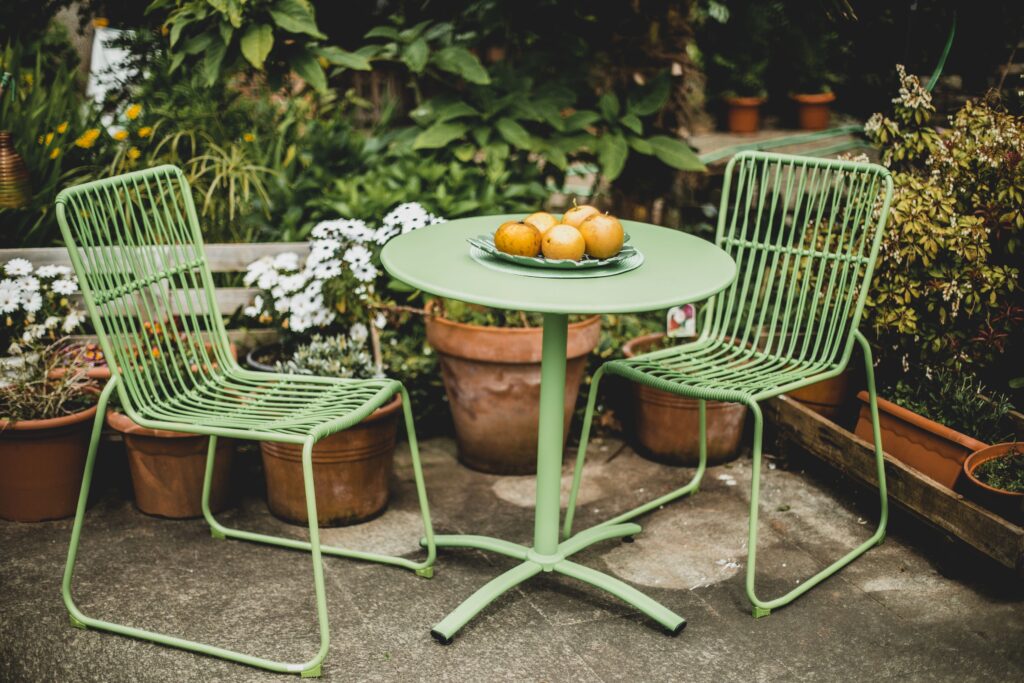
The demand for outdoor furniture and patio sets skyrocketed during the Covid-19 pandemic, as people spent more time at home and sought ways to spruce up their outdoor living spaces. However, this surge in demand has resulted in a shortage of patio furniture and outdoor products across the United States.
The supply chain from raw materials to finished products has been disrupted, causing delays in production and shipping. Some furniture makers have experienced an uptick in demand, but they are unable to meet the needs of consumers due to supply chain disruptions. Shipping firms and raw material suppliers have also been affected, leading to a shortage of shipping containers and raw materials needed for outdoor furniture production.
One of the main reasons for the patio furniture shortage is the industry’s dependence on Chinese furniture suppliers. China is a major outdoor furniture producer, and with the country being one of the earliest to be impacted by the pandemic, it led to significant delays in production and shipping. As a result, many retailers and suppliers had to diversify their supply chains, adding to the supply issues.
Moreover, the shortage of raw materials like polymer and aluminum has also contributed to the current situation. Chemical and polymer plants that create synthetic wicker and other materials used in outdoor furniture production temporarily closed due to the pandemic or were unable to fully operate due to supply chain disruptions. This led to an increase in prices for raw materials and, ultimately, an increase in the overall price of patio sets and outdoor furniture.
The outdoor furniture industry will likely continue to face supply issues in the coming months, but efforts are being made to address the situation. Furniture makers are diversifying their supply chains and implementing long-term solutions to ensure a steady supply of raw materials. Additionally, the government’s spending on stimulus packages may help alleviate some of the supply chain issues.
The shortage of patio furniture may persist for some time, and consumers should expect to pay higher prices for outdoor furniture and cushions. However, as the world recovers from the pandemic and manufacturers address the supply chain issues, the outdoor furniture industry is poised for growth and the possibility for even more innovative and durable outdoor products in the future.
Supply Chain Issues
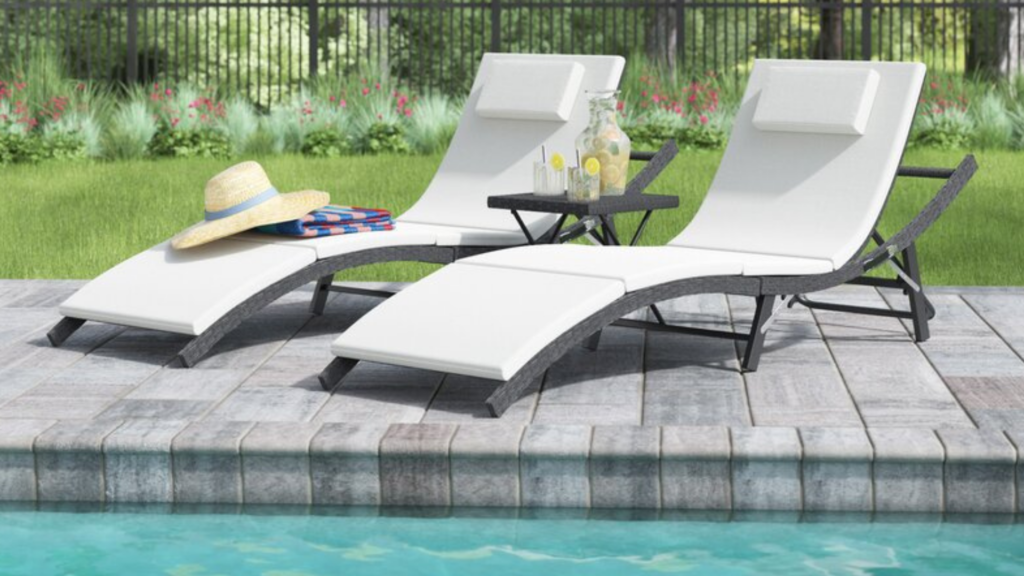
The furniture industry is no stranger to supply chain issues, but the COVID-19 pandemic has brought these challenges to the forefront like never before. With disruptions to production lines and shipping lanes, many retailers and manufacturers have experienced delays and shortages in the delivery of goods.
One of the primary factors contributing to the ongoing supply chain issues is the industry’s reliance on Chinese suppliers. As one of the world’s largest manufacturing hubs, China plays a critical role in the production of many furniture products. But with the pandemic hitting China early and hard, factories were forced to close, and shipping was delayed. As a result, companies around the world were left scrambling to find alternate suppliers.
Another major challenge is the shortage of raw materials, including polymers and aluminum. The shutdowns of chemical and polymer plants have left manufacturers grappling with dwindling supplies, while increased demand for patio sets and outdoor furniture has strained already-strained supply chains.
Some furniture makers have also reported difficulty sourcing shipping containers due to global shipping congestion, compounding the problem. Additionally, extreme weather events such as severe winter storms and hurricanes have added to shipping delays and supply chain problems.
As a result of these market forces, outdoor furniture retailers are facing a mix of affordability and availability issues. Demand has significantly outstripped supply, driving the prices of some products upwards. And even when patio sets are available, consumers may face lengthy wait times before receiving their purchases.
Manufacturers and suppliers are taking steps to address these supply chain issues. For example, some companies are diversifying their supply chains to reduce their reliance on a single source of materials or products. Others are investing in new technologies, such as blockchain, to increase transparency and accountability in their supply chains.
While these efforts may help to mitigate some of the current supply chain issues, the long-term solution may require a more fundamental restructuring of the industry. But with demand for durable and long-lasting products for outdoor living space projected to continue growing for generations, the industry’s stakeholders must act now to ensure future growth and profitability.
Raw Materials
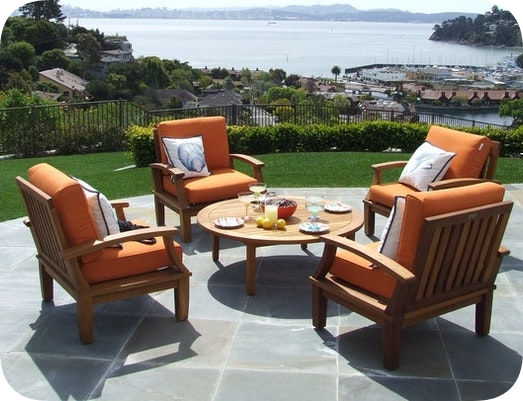
Raw materials are the building blocks of any product, and they play a critical role in the production of outdoor furniture. However, in recent times, there have been shortages of raw materials, such as polymers and aluminum, which has deepened the patio furniture shortage.
One critical factor in this shortage is the COVID-19 pandemic. The pandemic has caused global supply chain disruptions, factory shutdowns, and reduced production capacity. This has put significant pressure on the availability of raw materials that are critical to the furniture-making process. Many raw material producers have continued to face operational challenges like labor shortages and transportation issues, making it difficult for them to meet the furniture industry’s demand.
Another critical issue resulting in the shortage of raw materials is increased demand. With the growth in outdoor living space and patio sets, furniture makers have been unable to cope with the increased demand. This unanticipated demand has caught many raw material manufacturers off guard, and they lack the capacity to scale up production to meet higher demand levels.
Even with the increase in demand for raw materials, there have been production problems. Rampant wildfires, extreme weather events, and other environmental issues have hampered the mining and processing of some of these raw materials, further compounding the shortage problem.
The shortage of raw materials has put significant pressure on the furniture industry, leading to reduced production and a shrinking of supply chains. Patio furniture makers have been forced to cut back on production, raise prices, or limit their product range due to the lack of raw materials.
As the industry moves towards recovery, it is crucial for manufacturers, suppliers, and retailers to explore alternative sources of raw materials. Furthermore, there is a need for investment in machinery, innovation, and the development of new business policies that can address the global supply chain challenges and protect against future raw material shortages.
In conclusion, the shortage of raw materials is a significant problem that affects the entire outdoor furniture industry. As the industry seeks to overcome the challenges, manufacturers, suppliers, and raw material producers must work together to find innovative solutions that can address the supply chain issues and help meet the rising demand for patio furniture.
Chinese Furniture Suppliers
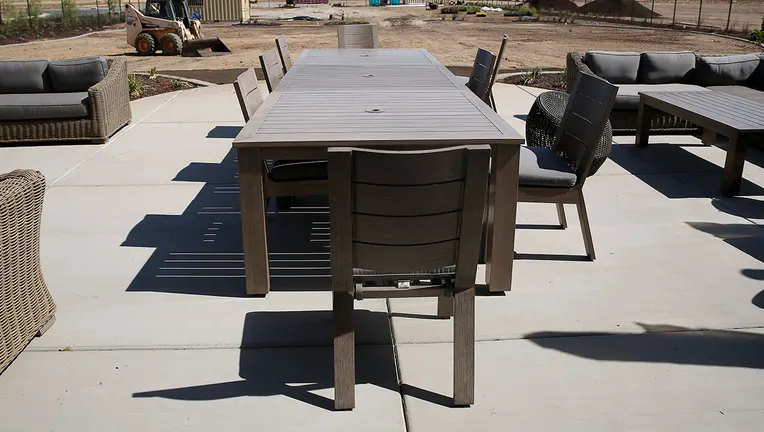
Chinese furniture suppliers have long been a major player in the global furniture industry, with many countries relying on China for affordable yet high-quality furniture. However, the pandemic has brought supply chain disruptions, shipping issues, and material shortages, leaving many wondering about the future of Chinese furniture supplies.
One significant impact of the pandemic on Chinese furniture suppliers has been factory shutdowns and reduced production capacity. Many factories were closed for months during the country’s initial outbreak, leading to significant delays in the production and shipment of furniture items. Although many have since reopened, the production capacity is still not at pre-pandemic levels.
Moreover, the pandemic has caused significant shipping issues that have made furniture delivery a tedious process. Many countries, including the United States, imposed restrictions on global trade, causing a multi-fold increase in shipping costs and significant delays in getting furniture supplies from China to the rest of the world.
Despite these challenges, Chinese furniture suppliers continue to play a crucial role in the industry. They cater to a different market segment, providing affordable furniture options to those looking for quality furniture on a budget. Furthermore, China remains a leading producer of certain materials like wood and steel, making them critical to the furniture industry’s supply chain.
As the world continues to navigate the pandemic, Chinese furniture suppliers are taking measures to adapt to the new normal. They are diversifying their manufacturing process, exploring alternative shipping options, and investing in improving production capacity to meet the increasing demand. Moreover, they are also implementing health and safety measures to prevent the spread of the virus in factories and working environments.
In conclusion, while the pandemic has brought significant challenges to Chinese furniture suppliers, they remain a crucial component of the global furniture industry. Their ability to adapt to the new normal, invest in new processes and technologies, and cater to different market segments makes them a valuable asset for furniture makers and consumers worldwide.
Domestic Supply Issues
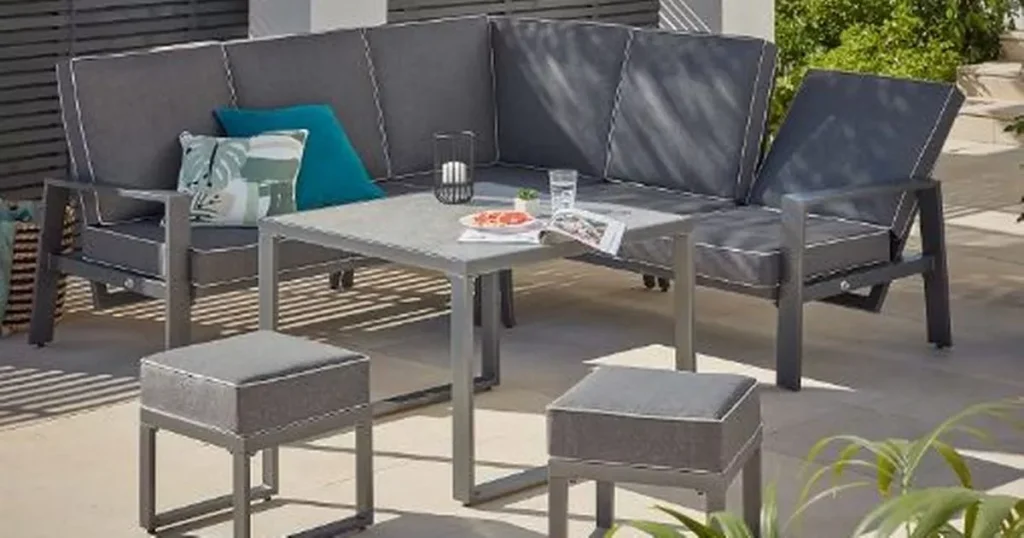
The COVID-19 pandemic has left an indelible mark on almost all sectors of the global economy, and the furniture industry is no exception. The outdoor furniture industry, in particular, has been hit hard, with many companies grappling with a shortage of raw materials and shipping containers, among other issues. One factor contributing to this problem is domestic supply issues.
Since the onset of the pandemic, demand for outdoor furniture has skyrocketed as more people spend time at home due to lockdowns and social distancing measures. Coupled with an uptick in home renovation projects and an increased interest in outdoor living spaces, the demand for patio furniture has surged. However, the increase in demand has put a strain on the supply chain, causing shortages of raw materials like aluminum, teak, and synthetic wicker, among others.
In addition to the rush for supplies, extreme weather events have also impacted domestic supply chains. For example, the recent cold snap in Texas and other parts of the southern United States caused a chemical plant in Texas to shut down temporarily, causing disruptions in the production of some polymer-based materials essential for making outdoor cushions and other products. Similarly, power outages in North Carolina have disrupted production at synthetic wicker manufacturers in the state, exacerbating the domestic supply squeeze.
Furthermore, the ongoing COVID-19 pandemic has created significant labor shortages and workplace disruptions across the industry. The virus has forced many manufacturers to reduce production capacity, shut down factories, and implement strict health and safety measures. As a result, companies are struggling to keep up with demand, despite investing in improving production capacity.
These domestic supply issues have led to lasting price bumps in outdoor furniture. Retailers, manufacturers, and shipping firms have been forced to pass on increased costs to consumers, leading to higher prices for patio sets and other outdoor furniture pieces. However, as the risk of inflation fades, some experts believe that the price increases may stabilize.
Overall, the patio furniture shortage can be attributed to a mix of market forces, including increased demand, supply issues, and disruptions to the supply chain caused by the pandemic and extreme weather events. In the short term, patio furniture buyers may need to exercise patience and flexibility in terms of product availability and pricing, while manufacturers and suppliers work to restore the domestic supply chain’s equilibrium.
Supply Squeeze and Rush for Supplies
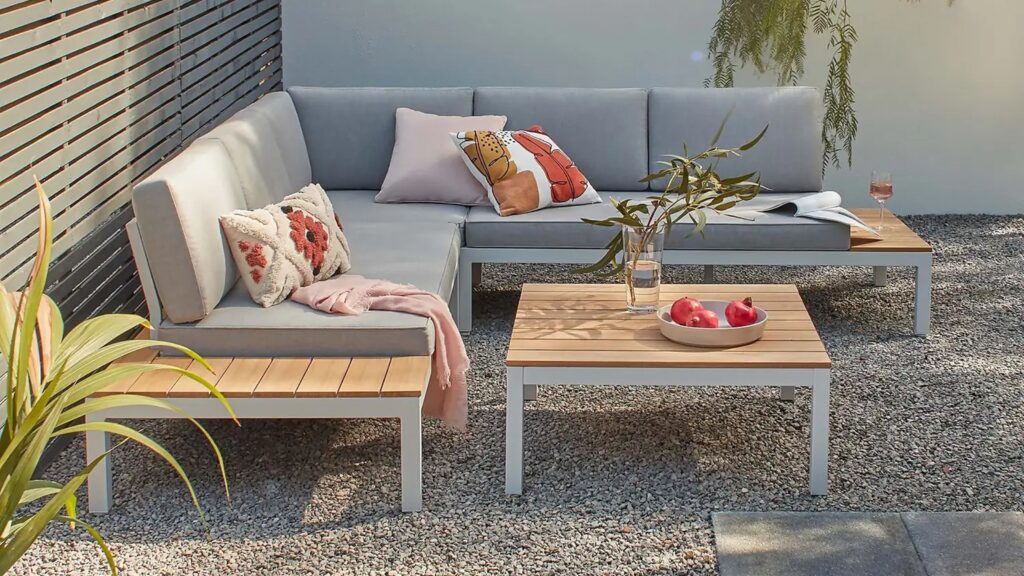
In recent months, the outdoor furniture industry has been facing a significant supply squeeze, with manufacturers struggling to keep up with the soaring demand for patio furniture. The ongoing COVID-19 pandemic, extreme weather events, and labor shortages have put a strain on the entire supply chain, causing a rush for supplies.
One of the primary drivers of the supply squeeze is the surge in demand for outdoor furniture. With more people spending time at home due to lockdowns and social distancing measures, many homeowners are investing in patio furniture to create inviting outdoor spaces. This has sparked a wave of home renovation projects, leading to an uptick in sales for furniture makers and outdoor products companies.
However, the sudden surge in demand has caught many suppliers off-guard, leading to a shortage of raw materials like aluminum, teak, and synthetic wicker. As companies struggle to keep up with orders, competition for supplies has intensified, leading to a rush for supplies.
Furthermore, the recent spate of extreme weather events has disrupted production at several factories, leading to supply chain bottlenecks and delays. For example, the recent cold snap in Texas caused a chemical plant to shut down temporarily, causing disruptions in the production of polymer-based materials essential for making outdoor cushions and other products.
Meanwhile, labor shortages stemming from the ongoing COVID-19 pandemic have made it difficult for manufacturers to keep up with demand. Companies have had to reduce production capacity, shut down factories, and implement strict health and safety measures to comply with local regulations. As a result, the industry has been grappling with significant capacity constraints, further exacerbating the supply squeeze.
Despite these challenges, many companies are working to invest in improving their production capacity and supply chains. Some are looking to diversify their supply base, seeking out new suppliers for raw materials in different regions. Others are ramping up their investments in automation and technology to improve efficiency, while also exploring new shipping routes and delivery methods to mitigate the impact of supply chain disruptions.
In conclusion, the supply squeeze and rush for supplies facing the outdoor furniture industry is a complex issue that has been exacerbated by a mix of market forces, weather-related disruptions, and the ongoing COVID-19 pandemic. While the challenges are significant, industry players remain determined to find innovative solutions and improve resiliency across the entire supply chain.
Impact of Jordan Neely’s Outdoor Furniture Company

Jordan Neely’s outdoor furniture company has had a significant impact on the patio furniture industry since its inception. Neely, a seasoned entrepreneur with years of experience in the furniture industry, founded the company with a mission to create high-end, yet affordable patio furniture that would withstand the test of time.
Neely’s company quickly gained traction in the market, thanks to its use of durable materials like aluminum and synthetic wicker, as well as its commitment to quality craftsmanship. The furniture quickly became known for its sleek designs, comfortable seating, and weather-resistant properties, making it an instant hit with homeowners who were looking to create stylish outdoor living spaces.
But Neely’s impact on the outdoor furniture industry doesn’t stop there. His company has also led the way in terms of supply chain efficiency and sustainability. By investing in automation and technology, Neely’s company has been able to streamline the production process, reducing the time and resources required to create each piece of furniture. This has not only improved productivity and efficiency, but it has also reduced the company’s carbon footprint, making it a more sustainable and environmentally-friendly choice for consumers.
Additionally, Neely’s dedication to domestic supply and production has helped to boost the local economy. His company works with a network of skilled manufacturers and suppliers across the United States, supporting local businesses and creating jobs in various regions. This commitment to domestic supply and production has also helped to mitigate the impact of supply chain disruptions that have plagued the industry in recent years.
Overall, Jordan Neely’s impact on the outdoor furniture industry has been immense. Through his commitment to quality, sustainability, and domestic production, he has not only created a successful business but has also set a standard on how to thrive in the industry while positively impacting the economy and the environment.
Types of Outdoor Furniture in High Demand
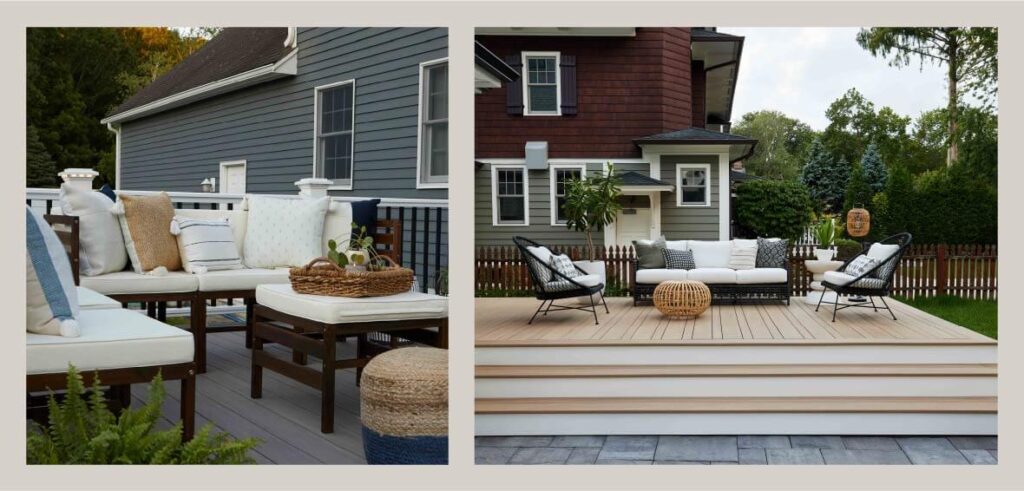
As more and more people look to spruce up their outdoor living spaces, there has been a surge in demand for outdoor furniture. From patio sets to outdoor chairs, there are a variety of different types of outdoor furniture that are proving especially popular. Here are some of the outdoor furniture types that are currently experiencing high demand:
1. Outdoor Dining Sets
As gatherings with friends and family move outdoors, outdoor dining sets have become a must-have for many homeowners. These sets typically include a dining table and chairs designed to withstand the elements. Options range from high-end, large-scale sets with intricate details to more simple, streamlined sets that are perfect for casual get-togethers.
2. Outdoor Lounge Furniture
Outdoor lounge furniture, designed for relaxing in the sun or under a shaded area, is another type of outdoor furniture that is very popular these days. From cushioned chaise lounges to oversized deep seating sectional sofas and daybeds, homeowners have plenty of options to choose from when it comes to creating a comfortable outdoor lounge space.
3. Adirondack Chairs
Perhaps one of the most iconic pieces of outdoor furniture, Adirondack chairs are experiencing a resurgence in popularity. These classic wood chairs are perfect for a cabin or a cottage, and often come in bright, bold colors that can add a playful touch to any outdoor space.
4. Outdoor Fire Pits
Outdoor fire pits have become increasingly popular in recent years and are a great way to keep warm during chilly nights while enjoying the outdoors. Fire pits come in a variety of shapes and sizes and can be fueled by wood, propane, or natural gas.
5. Outdoor Sectionals
Outdoor sectional sofas provide ample seating space and have become a popular furniture choice for large decks and patios. These sofas are perfect for entertaining guests or simply lounging outdoors.
Overall, there are a wide range of outdoor furniture types that are currently in high demand, reflecting the growing trend of more people looking for ways to extend their living spaces beyond their four walls. Whether you’re looking for relaxed lounge chairs or an elegant dining set, there are plenty of options to choose from.
Aluminum Furniture
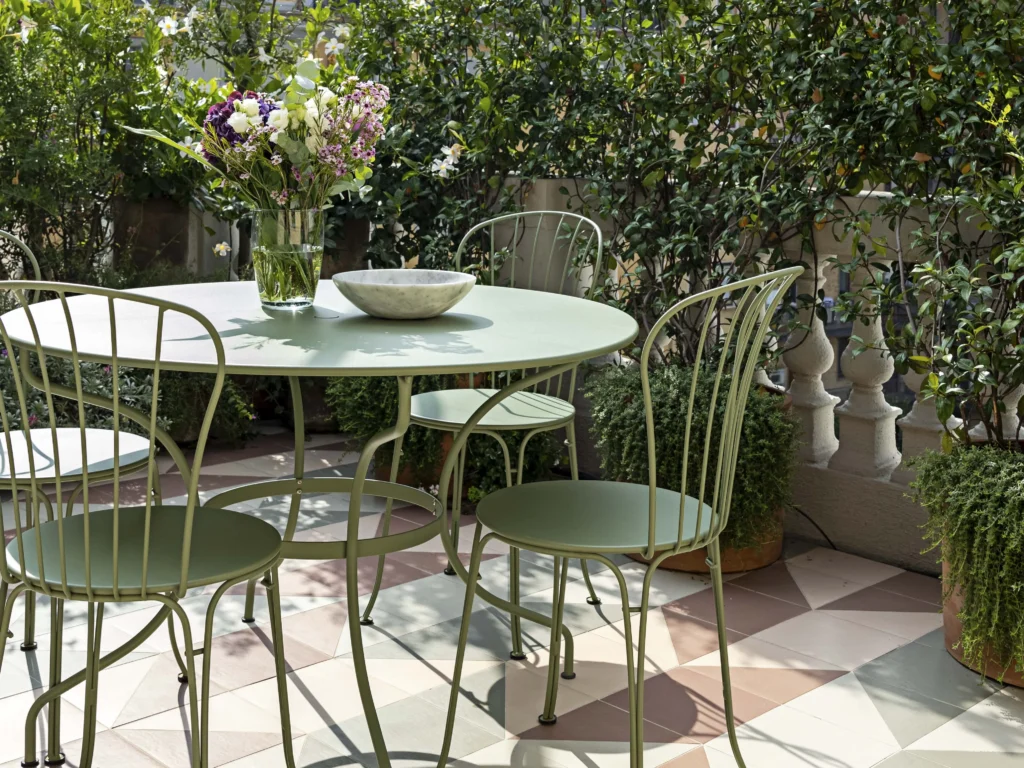
Aluminum furniture is a popular choice for many homeowners, thanks to its durability and ability to withstand the elements. This type of furniture is made from lightweight, yet strong aluminum, which makes it perfect for outdoor use. From patio dining sets to lounge chairs and even fire pits, aluminum furniture comes in a wide variety of styles and designs.
One of the biggest advantages of aluminum furniture is its low maintenance requirements. Unlike other types of outdoor furniture, such as wood or wicker, aluminum furniture doesn’t require staining or sealing to protect it from the sun and rain. This makes it a great option for those who don’t want to spend a lot of time and effort maintaining their outdoor furniture.
Another advantage of aluminum furniture is its versatility. This type of furniture is lightweight and easy to move around, meaning you can easily re-arrange your outdoor living space to suit your needs. Aluminum furniture also comes in a wide range of styles, from modern and sleek to traditional and ornate, so it’s easy to find something that suits your personal taste.
One potential downside of aluminum furniture is that it can get hot in direct sunlight. However, many manufacturers offer cushions or fabrics specifically designed to help keep the furniture cool. It’s also important to note that not all aluminum furniture is created equal. Some manufacturers use lower quality aluminum that is more susceptible to denting and scratching, so it’s important to choose a reputable brand when selecting your furniture.
Overall, aluminum furniture is a great option for those looking for durable and low maintenance outdoor furniture. With its versatility and wide range of styles, it’s easy to find something that fits your needs and personal style.
Durable Material
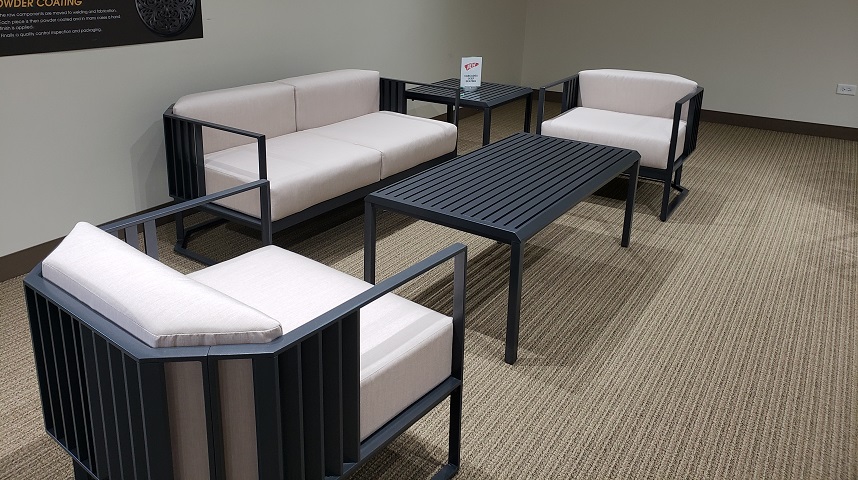
When it comes to choosing outdoor furniture, durability is a key factor to consider. You want furniture that will last for years to come, withstand various weather conditions, and still look great. This is where the choice of material becomes crucial.
There are several materials that make for durable outdoor furniture, including aluminum, wrought iron, teak, and synthetic wicker. Each of these materials has its own unique advantages and considerations.
Aluminum furniture is one of the most popular choices for outdoor furniture due to its lightweight and low maintenance requirements. It is also resistant to rust and corrosion, making it a durable choice for outdoor use. However, it can get hot to the touch in direct sunlight and may not be as sturdy as other materials.
Wrought iron furniture is a classic choice for outdoor furniture. It is sturdy, heavy, and can withstand extreme weather conditions. However, it is susceptible to rust and requires some maintenance to prevent rusting.
Teak furniture is another popular choice for outdoor furniture. It is a hardwood that is known for its durability and resistance to outdoor elements. It will develop a beautiful and unique patina over time if left untreated, but can also be treated to maintain its original color and shine.
Finally, synthetic wicker furniture is an alternative to natural wicker that is becoming increasingly popular. It is made from durable resin fibers that are resistant to fading, cracking, and other outdoor wear and tear. It also requires little maintenance and can be easily cleaned with soap and water.
Overall, the key to choosing durable outdoor furniture is selecting a material that can withstand the elements and still look good after years of use. With careful consideration and maintenance, any of these materials can make for a great addition to your outdoor living space.
Patio Sets and Individual Pieces of Furniture

The demand for outdoor furniture has increased significantly as more people seek to enhance their outdoor living space. The pandemic has forced many people to spend more time at home, and they want their outdoor space to be as comfortable and inviting as their indoor space.
When it comes to outfitting an outdoor living area, consumers can choose between patio sets or individual pieces of furniture. Patio sets typically include a table and chairs, and sometimes other pieces such as an umbrella or sectional seating. These sets offer a cohesive look and are designed to fit together.
However, some consumers prefer to mix and match individual pieces of furniture to create a customized outdoor living space. This allows them to choose pieces that fit their specific needs and style preferences. They can select chairs, a sofa, coffee table, and other pieces separately, and create a unique look that fits their personality and lifestyle.
Both patio sets and individual pieces have their advantages and disadvantages. Patio sets are a great option for those who want a coordinated look and do not want to spend extra time selecting and arranging furniture. They are also a good option for those with limited outdoor space since they typically come in smaller sizes and can be more space-efficient.
On the other hand, individual pieces offer more flexibility and allow consumers to create a look that is unique to their tastes. They can mix and match different materials and styles to achieve a personalized look. They can also choose pieces that fit their specific needs, such as loungers for sunbathing or an oversized chair for curling up with a book.
Regardless of whether consumers choose patio sets or individual pieces, they should prioritize quality and durability. Outdoor furniture is exposed to the elements and can quickly deteriorate if it is not made from high-quality materials that can withstand the sun, rain, and wind. Factors such as material, construction, and finishing also play a role in determining the durability and longevity of outdoor furniture.
In addition to quality, consumers should also consider their budget, style preferences, and the size of their outdoor space when selecting furniture. They should take measurements to ensure that the furniture fits well in their space and allows room for movement. With a little research and planning, consumers can create an outdoor living area that is both functional and stylish.
High-End Patio Furniture

High-end patio furniture is known for its luxurious design, exceptional quality, and superior materials that offer both form and function. These pieces are designed to withstand the elements and maintain their elegance for years to come.
High-end patio furniture is made from a variety of materials such as teak, wrought iron, aluminum, and all-weather wicker. These materials are known for their durability and longevity, making them a great investment for anyone looking to create a beautiful outdoor living space.
Teak, for example, is a hardwood that is naturally resistant to rot, decay, and insects. It has a beautiful natural color that fades over time to a stunning silver-gray patina. Wrought iron is another popular material for high-end patio furniture, known for its strength and durability. It is often used in ornate designs that offer an old-world charm.
Aluminum is another material commonly used for high-end patio furniture. It is lightweight, making it easy to move around, and offers exceptional weather resistance. All-weather wicker is also a popular choice, offering a timeless look that is both stylish and functional. It is made from synthetic fibers that mimic the look and feel of traditional wicker but are more durable and resistant to the elements.
In addition to their superior materials, high-end patio furniture pieces feature exceptional design and craftsmanship. From intricate details to seamless construction, these pieces offer the perfect blend of form and function. They are often customizable, allowing homeowners to choose from a range of colors, fabrics, and finishes to create a look that is uniquely their own.
While high-end patio furniture may come with a higher price tag, it is important to remember that these pieces are a long-term investment in your home and outdoor living space. They are built to last, providing years of enjoyment and relaxation.
In conclusion, high-end patio furniture is a luxurious and practical option for anyone looking to create an outdoor living space that is both beautiful and functional. With a range of materials, designs, and customization options available, there is something to suit every taste and style preference. So, if you want to elevate your outdoor living experience, consider investing in high-end patio furniture.
Impact of the Shortage on Outdoor Space Designers and Consumers
The ongoing shortage in patio furniture has had a significant impact on outdoor space designers and consumers alike. With many people spending more time at home due to the COVID-19 pandemic, the demand for outdoor furniture has skyrocketed. However, the supply chain and raw materials have been greatly affected by the pandemic, leading to a shortage of patio sets and other outdoor furniture products.
For outdoor space designers, the shortage has meant finding creative solutions to meet their clients’ needs. They may need to look for alternatives to traditional patio furniture or find ways to repurpose indoor furniture for outdoor use. Some designers have turned to using durable materials like synthetic wicker to create furniture pieces that are both stylish and weather-resistant.
On the consumer side, there has been frustration over the lack of availability of outdoor furniture products. Consumers have had to either wait lengthy periods for back-ordered items, search for alternatives or pay premium prices for expedited shipping. Some have even turned to purchasing outdoor furniture from overseas companies, which have added further logistical challenges to the supply chain.
The shortage has also led to some lasting price bumps, with outdoor furniture companies passing on increased shipping costs and manufacturing difficulties to the consumer. This has resulted in some consumers holding off on purchasing outdoor furniture until the market stabilizes.
At the same time, there have been reports of a rush for supplies, with many people wanting to capitalize on the fastest growth in generations for home improvement and outdoor products. The demand for outdoor chairs, cushions, and decorations has also increased, further straining the already limited supply chain.
Overall, the shortage of patio furniture has been a mix of market forces brought on by the global pandemic. Despite the challenges, outdoor space designers and consumers are continuing to find ways to create beautiful and functional outdoor living spaces that suit their needs. With the risk of inflation fades and government dollars spent in boosting the economy, there is hope that the industry will recover and thrive, meeting the demands of those who prioritize a well-designed outdoor living space.
How the Shortage Can Be Addressed
As the demand for outdoor furniture continues to surge, the shortage plaguing the industry shows no signs of easing up. However, there are steps that can be taken to address the issue and help provide relief to consumers and the industry alike.
One key factor driving the shortage of patio furniture is the disruption in the global supply chain caused by the COVID-19 pandemic. Manufacturing shutdowns, shipping delays and increased demand for a variety of products have led to a backlog of raw materials and limited availability of shipping containers. This has made it extremely difficult for furniture makers to procure the necessary resources to produce and transport their products.
To address this issue, companies in the furniture industry can explore domestic supply sources and reduce their reliance on Chinese furniture suppliers. This could help mitigate some of the supply issues and alleviate the squeeze on shipping containers. It could also create new opportunities for growth in the garden supply chain, boosting local economies and creating new jobs in the process.
In addition, investing in durable materials such as aluminum, synthetic wicker and weather-resistant cushions could help increase the lifespan of outdoor furniture, making it that much more valuable for consumers. Furniture makers should also consider diversifying their product lines to accommodate emerging trends and meet consumer needs.
Furthermore, the government can play a role in supporting the furniture industry and addressing the current shortage. Increased government dollars could be allocated towards the creation of new job opportunities, supporting manufacturers, and helping develop the power grid necessary to stabilize the supply chain.
Although the current shortage of outdoor furniture is daunting to both consumers and industry players, there are steps that can be taken to address the issue. By focusing on domestic supply chains, investing in durable materials and diversifying product lines, we can work towards reducing the strain on the supply chain and meet the growing demand for outdoor furniture.

